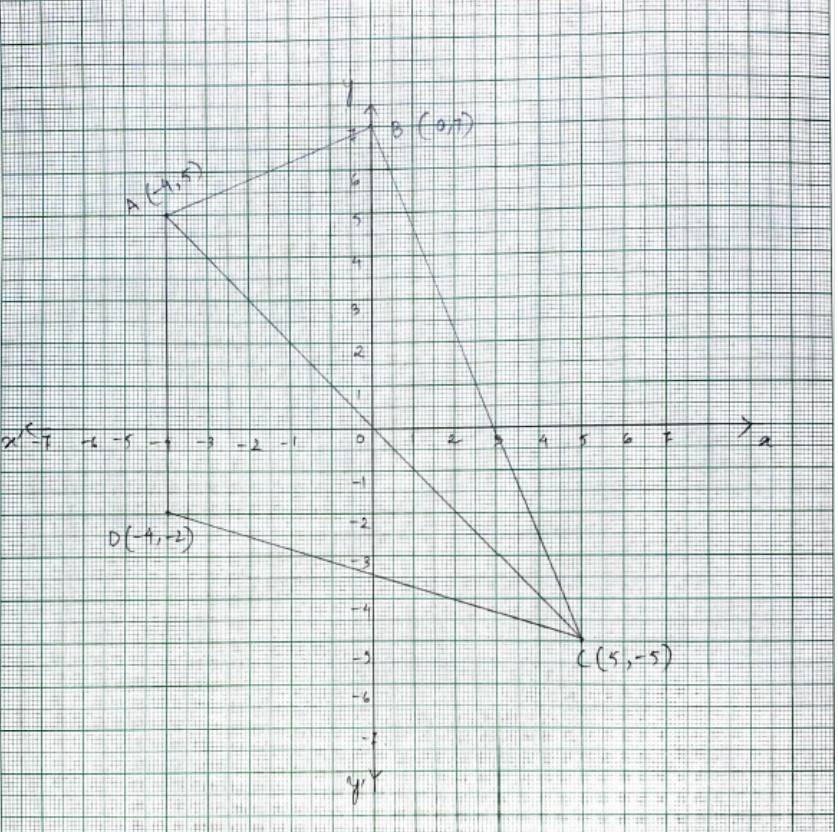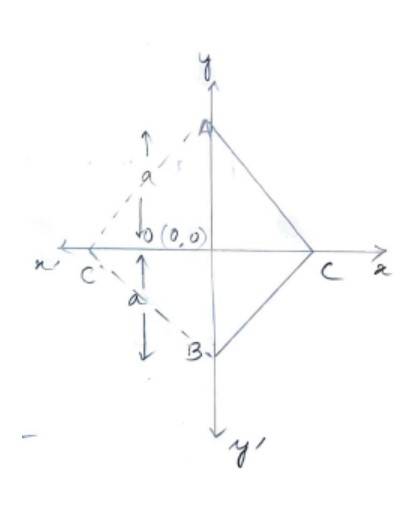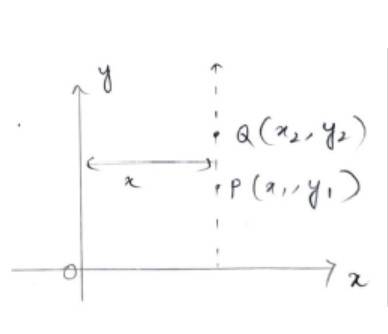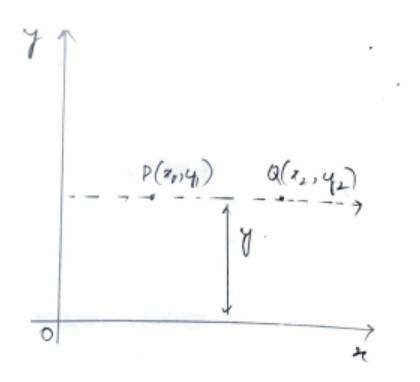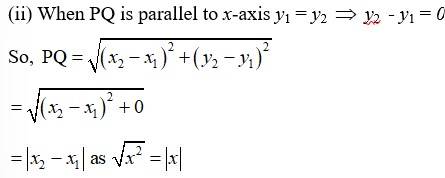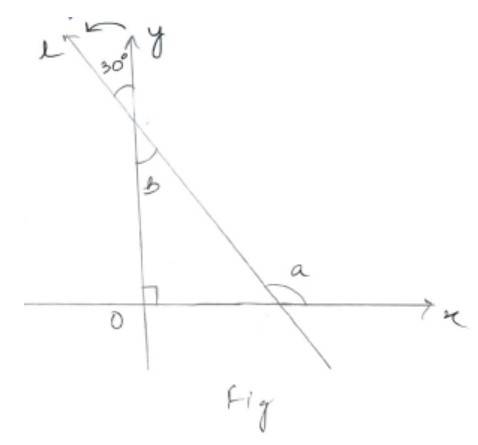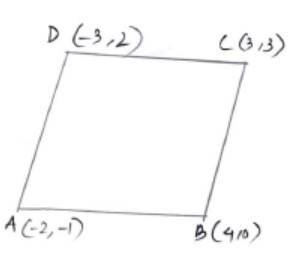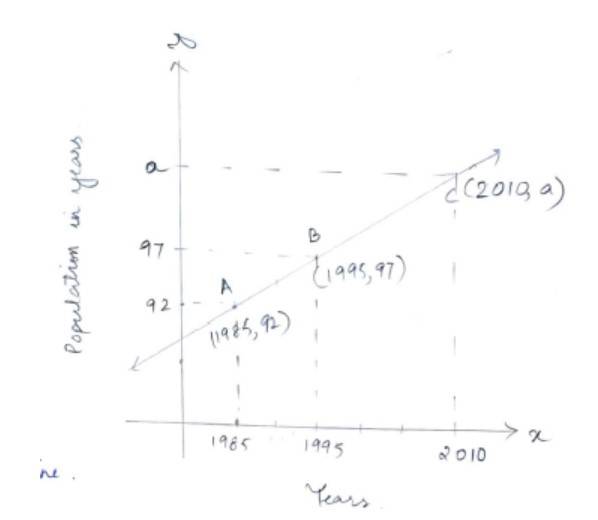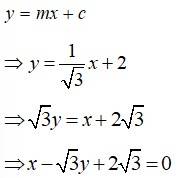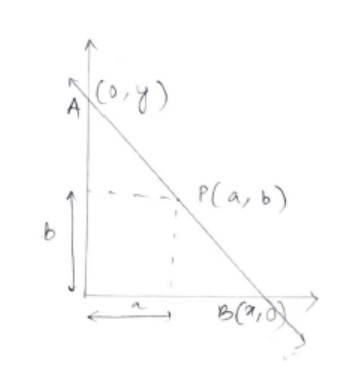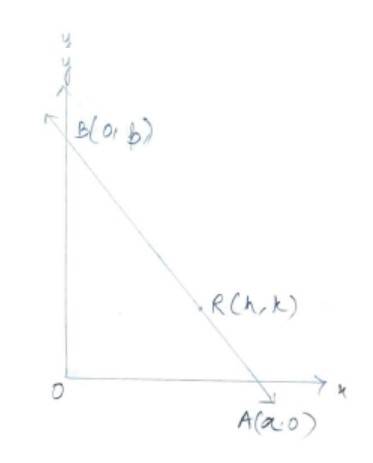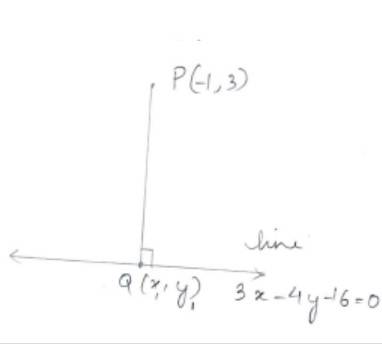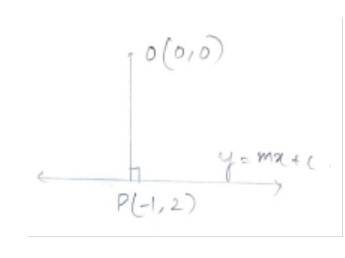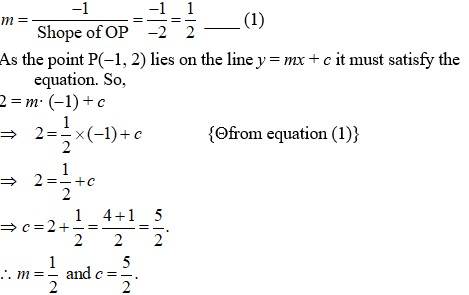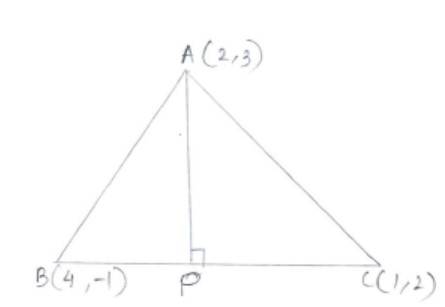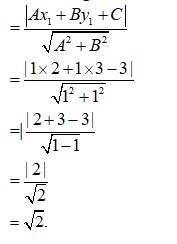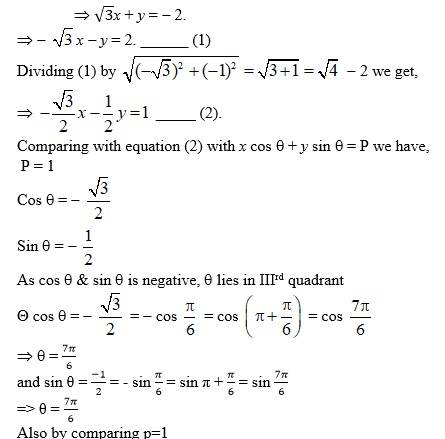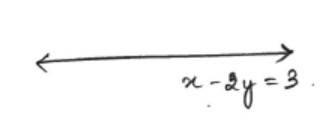
Straight lines Class 11 NCERT solutions: Students can find the NCERT Solutions Maths Class 11 Chapter 9 Straight lines on this page. They are advised to make use of the Class 11 Straight lines to prepare for the annual exam as well as entrance exams. We have provided step by step solutions of NCERT Maths Class 11 Chapter 9 Straight lines. Students can easily understand the problems since the solutions are given in a detailed manner. They can download NCERT Solutions Maths Class 11 Chapter 9 Straight lines PDF for free.
NCERT Solutions Maths Class 11 Chapter 9 Straight lines consists of three exercises and one miscellaneous exercise. There are many formulas present in this chapter which are very important for solving the problems. Students should learn these formulas thoroughly so that they can score high marks from this chapter. Students can access out NCERT Solutions for free.
Topics Covered - Straight Lines
- Slope of a line
- Various Forms of the Equation of a Line
- General Equation of a Line
- Distance of a Point from a Line
Check the NCERT Solutions Maths Class 11 Chapter 9 Straight lines below.
Q10.5 Find the slope of a line, which passes through the origin, and the mid-point of the line segment joining the points P (0, – 4) and B (8, 0).
A10.5Let 0(0, 0) be the origin and A be the mid-point of line joining P(0, –4) and B(8, 0)
Then, co-ordinate of A = ( x1 + x2 / 2, y1 + y2 / 2) = ( 0+8 / 2, -4+0 / 2) = (4,-2)
Slope of OA, m = y2 - y1 / x2 - x1 = -2-0 / 4-0 = -2/4 = -1/2
Q 10.6 Without using the Pythagoras theorem, show that the points (4, 4), (3, 5) and (–1, –1) are the vertices of a right angled triangle.
A 10.6 Let the given point be A(4, 4), B(3, 5) and C(–1, –1)
Then, slope of AB, m1 = 5-4 / 3-4 = 1/-1 = -1
Slope of AC, m2 = -1/-4 / -1/-4 = -5/-5 = 1
And slope of BC, m3 = -1/-5 / -1/-3 = -6/-4 = 3/2
As m1 – m2 = –1 × 1 = –1
m1 = -1/m2
We conclude that AB and AC are perpendicular to each other.
Hence, ABC is a right-angle triangle right-angled at A
Q 10.8 Find the value of x for which the points (x, – 1), (2,1) and (4, 5) are collinear.
A 10.8
Let P(x, –1), Q(2, 1) and R(4, 5) be the collinear points. Then,
Slope of PQ = Slope of QR
1-(-1) / 2-x = 5-1 / 4-2
1+1 / 2-x = 4/2
2 X 2 = 4 (2-x)
4 = 8-4x
x = 4/4
x = 1
Download Here NCERT Class 11th Maths Chapter 9 Straight Lines Solutions PDF
- Straight Lines Class 11 NCERT Solutions and FAQs
Straight Lines Class 11 NCERT Solutions and FAQs
Exercise 10.1
Q1. Draw a quadrilateral in the Cartesian plane, whose vertices are (– 4, 5), (0, 7),
(5, – 5) and (– 4, –2). Also, find its area.
A.1. Let the given points be A(–4, 5), B(0, 7), C(5, –5) and D(–4, –2).
Then quadrilated ABCD can be plotted on the graph by joining the points A, B, C and D.
We connect diagonal AC such that
area (ABCD) = (ΔABC) + (ΔADC)
Now,
Similarly,
Hence, area (ABCD) =
Q2. The base of an equilateral triangle with side 2a lies along the y-axis such that the mid-point of the base is at the origin. Find vertices of the triangle.
A.2. Let ABC be the equilateral triangle of side 2a and 0 be the origin. Then
AB = BC = AC = 2a
O is the mid-point of AB we have AO = a
BO = a
We know that A and B lies on y-axis so they have co-ordinate of the form (0, y).
Hence, co-ordinate of A is (0, a) and that of B is (0, –a)
Since OC, bisects AB at right angle, by Pythagoras theorem,
AC2= OA2 + OC2
And as C we on x-axis it has co-ordinate of the form (x, 0)
Q3. Find the distance between P (x1, y1) and Q (x2, y2) when : (i) PQ is parallel to the y-axis, (ii) PQ is parallel to the x-axis.
Q4. Find a point on the x-axis, which is equidistant from the points (7, 6) and (3, 4).
A.4. Let A(x, 0) be the point on x-axis when is equidistant from P(7, 6) and Q(3, 4)
Then, PA = QA
Squaring both sides, we get,
The required point on x-axis is
Q5. Find the slope of a line, which passes through the origin, and the mid-point of the line segment joining the points P (0, – 4) and B (8, 0).
A.5. Let 0(0, 0) be the origin and A be the mid-point of line joining P(0, –4) and B(8, 0)
Then, co-ordinate of A =
Slope of OA, m =
Q6. Without using the Pythagoras theorem, show that the points (4, 4), (3, 5) and (–1, –1) are the vertices of a right angled triangle.
A.6. Let the given point be A(4, 4), B(3, 5) and C(–1, –1)
Then, slope of AB, m1 =
Slope of AC, m2 =
And slope of BC, m3 =
As m1 – m2 = –1 × 1 = –1
We conclude that AB and AC are perpendicular to each other.
Hence, ABC is a right-angle triangle right-angled at A
Q7. Find the slope of the line, which makes an angle of 30°with the positive direction of y-axis measured anticlockwise.
A.7. Let l be the line making 30° with y-axis as shown in figure. Then,
Angle a = + 90° (Sum of exterior angle of a triangle)
( vertically opposite angle)
So, slope of line l = tan a
= m = tan 120°
= tan(180° – 60°)
= –tan 60°
Q8. Find the value of x for which the points (x, – 1), (2,1) and (4, 5) are collinear.
A.8. Let P(x, –1), Q(2, 1) and R(4, 5) be the collinear points. Then,
Slope of PQ = Slope of QR
Q9. Without using distance formula, show that points (– 2, – 1), (4, 0), (3, 3) and (–3, 2) are the vertices of a parallelogram.
A.9. Let A(–2, –1), B(4, 0), C(3, 3) and D(–3, 2) be the given points.
Slope of DC =
As slope of AB = slope of DC
We conclude that AB | | DC.
Similarly, slope of BC =
Slope of AD =
As slope of BC = slope of AD we conclude that BC | | AD.
Hence, as the pair of opposite sides of ABCD are parallel we can conclude that the given points are the vertices of a parallelogram.
Q10. Find the angle between the x-axis and the line joining the points (3,–1) and (4,–2).
A.10. Slope of line joining points A(3, –1) and B(4, –2) is
As slope of AB is the angle made by the line-segment AB w.r.t. x-axis, the angle between them is and is given by
Q11. The slope of a line is double of the slope of another line. If tangent of the angle between them is , find the slopes of the lines.
A.11. Let the two slopes be m and 2m. And if Θ is the angle between the two lines.
Case I. When
Case II. When
Hence,
The possible slopes of the two lines (m, 2m) are (1, 2), and
Q12. A line passes through (x1, y1) and (h, k). If slope of the line is m, show that k – y1 = m (h – x1).
A.12. Let the line l passes through points (x1, y1) and (h, x)
Then slope of l,
Hence, proved
Q13. If three points (h, 0), (a, b) and (0, k) lie on a line, show that .
A.13. Since the three points say P(h, o), Q(a, b) and R(o, k) lie on a line.
Slope of PQ = slope of QR
Dividing both sides by kh we get,
Q14. Consider the following population and year graph (Fig 10.10), find the slope of the line AB and using it, find what will be the population in the year 2010 ?
A.14. From figure,
Slope of AB =
As, A, B and C lie on same line
Slope of AB = Slope of BC
Hence, population in 2010 will be 104.5 crores.
Exercise 10.2
In Exercises 1 to 8, find the equation of the line which satisfy the given conditions:
Q1. Write the equations for the x-and y-axes.
A.1. For any points on x-axis the y-co-ordinate or the ordinate is always 0. Hence, the x-axis have the equation y = 0.
Similarly for xy points on y-axis the x-co-ordinate or the abscissa is always 0. Hence, the y-axis have the equation x = 0.
Q2. Passing through the point (– 4, 3) with slope .
A.2. Given,
By point slope form equation of line is
Q3. Passing through (0, 0) with slope m.
A.3. Given slope = m and
By point slope from, equation of line is
Q5. Intersecting the x-axis at a distance of 3 units to the left of origin with slope –2.
A.5. Given m = –2
x-intercept, d = –3
Using slope intercept form, equation of line is
y = m(x – d)
Q6. Intersecting the y-axis at a distance of 2 units above the origin and making an angle of 30o with positive direction of the x-axis.
A.6. The slope of the line is m = tan 30° =
And x-intercept, c = 2
Using slope intercept form, equation of line is
Q7. Passing through the points (–1, 1) and (2, – 4).
A.7. Here (x1, y1) = (–1, 1) and (x2, y2) = (2, –4)
Using two point form, equation of line is
Q9. The vertices of ΔPQR are P (2, 1), Q (–2, 3) and R (4, 5). Find equation of the median through the vertex R.
= (0, 2)
So equation of line passing through R(4, 5) and M(0, 2) is
Q10. Find the equation of the line passing through (–3, 5) and perpendicular to the line through the points (2, 5) and (–3, 6).
A.10. Slope of line passing through points (2, 5) and (–3, 6) is
So, slope of line perpendicular to line through (2, 5) and (–3, 6) is
Equation of line with slope 5 and passing through (–3, 5) is
Q11. A line perpendicular to the line segment joining the points (1, 0) and (2, 3) divides it in the ratio 1: n. Find the equation of the line.
A.11. Let P(1, 0) and Q(2, 3) be the given points. Then, slope of line joining PQ,
If A divides PQ with ratio 1:n, co-ordinate of A is
So, slope of line perpendicular to line joining points P and Q
Hence, equation of line passing through point A and (perpendicular to line) joining points P and Q is given by
Q12. Find the equation of a line that cuts off equal intercepts on the coordinate axes and passes through the point (2, 3).
A.12. Let the line cuts x and y axis at intercept c. Then a = b = c
Then by intercept form the equation of line is
Since equation (1) passes through point (2, 3).
Hence 2 + 3 = c
So, substituting value of c in equation (1) we get
Q13. Find equation of the line passing through the point (2, 2) and cutting off intercepts on the axes whose sum is 9.
A.13. Let a and b be the intercepts on x and y-axis
Then a + b = 9
Using intercept form equation of line with a and b intercepts are
As point (2, 2) passes the line having equation of form equation (2) we can write as
So, a = 3, 6
Case I
When a = 3, b = 9 – 3 = 6. Then the equation of line is
Case II
When a = 6, b = 9 – 6 = 3. Then equation of line is
Hence, equation of line is 2x + y – 6 or x + 2y – 6 = 0
Q15. The perpendicular from the origin to a line meets it at the point (–2, 9), find the equation of the line.
A.15. The slope of line passing through (0, 0) and (–2, 9) is
The line perpendicular to the line having slope m1 will have the slope
So, the equation of line with slope m2 and passing is
Q16. The length L (in centimetre) of a copper rod is a linear function of its Celsius temperature C. In an experiment, if L = 124.942 when C = 20 and L= 125.134 when C = 110, express L in terms of C.
A.16. Assuming L along y-axis and C along x-axis, we have two points (124.942, 20) and (125.134, 110) in xy-plane. By two-point form, the point L and C satisfies the equation.
y-124.942= (x-20)
y-124.942= (x - 20)
y-124.942= (x - 20)
15y – 1874.13=0.032x -0.64
15y= 0.032x +1873.49
y = 0.0021x+124.8993
L = 0.0021C + 124.8993
Q17. The owner of a milk store finds that, he can sell 980 litres of milk each week at Rs 14/litre and 1220 litres of milk each week at Rs 16/litre. Assuming a linear relationship between selling price and demand, how many litres could he sell weekly at Rs 17/litre?
A.17. Assuming the price per litre say P in x-axis and the corresponding demand say D in y-axis, we have two point (14, 980) and (16, 1220) in xy plane. Then the points (P, D) will satisfy the equation.
Q18. P (a, b) is the mid-point of a line segment between axes. Show that equation of the line is .
A.18. Since P(a, b) is the mid-point of the line segment say AB with points A(0, y) and B(x, 0) we can write,
So, the equation of line with x and y intercept 2a and 2b using intercept form is
Hence, proved
Q19. Point R (h, k) divides a line segment between the axes in the ratio 1: 2. Find equation of the line.
A.19. Equation of line with intercept form is
As R(h, x) divides line segment joining point A(a, 0) and B(0, b) in the ratio 1 : 2 we can write,
So,
Hence, putting value of aandb in equation (1) we get,
Q20. By using the concept of equation of a line, prove that the three points (3, 0), (– 2, – 2) and (8, 2) are collinear.
A.20. Let the given points be A(3, 0), B(–2, –2) and C(8, 2). Then by two point form we can write equation of line passing point A(3, 0) and B(–2, –2) as
If the three points A, B and C are co-linear, C will also lieonm the line formed by AB or satisfies equation (1).
Hence, putting x = 8 and y = 2 we have
L.H.S. = 2 × 8 – 5 × 2 – 6
= 16 – 10 – 6
= 0 = R.H.S.
The given three points are collinear.
Exercise 10.3
Q1. Reduce the following equations into slope - intercept form and find their slopes and the y - intercepts.
(i) x + 7y = 0, (ii) 6x + 3y – 5 = 0, (iii) y = 0.
A.1. (i) Given, x + 7y = 0.
7y = -x
y = x + 0.
Comparing the above equation with y = mx + c we get, slope, m = - and c = 0, y-intercept
(ii) Given, 6x + 3y - 5 = 0
3y = -6x + 5
y = - x + = -2x +
Comparing the above equation with y = mx + c we get, slope, m = -2 and , y-intercept
(iii) Given, y = 0
y = 0xx + 0
Comparing the above equation with y = mx + c we get, Slope, m = 0 and c = 0,y-intercept.
Q2. Reduce the following equations into intercept form and find their intercepts onthe axes.
(i) 3x + 2y – 12 = 0, (ii) 4x – 3y = 6, (iii) 3y + 2 = 0.
A.2. (i) Given, 3x + 2y 12 = 0.
3x + 2y = 12
Dividing both sides by 12 we get,
Comparing the above equation with = we get, x-intercept, a = 4 and y-intercept b = 6.
(ii) Given, 4x - 3y = 6
Dividing the both sides by 6.
Comparing above equation by we get, x-intercept a = and y-intercept, b = -2
(iii) Given, 3y + 2 = 0.
3y = -2
As the equation of line is of form y = constant, it is parallel to x-axis and has no x-intercept.
Qy-intercept = -
As w lies in IVth quadrant
Cos w = cos 45 ° and sin w = sin 45°
= cos (360° - 45°)= sin (360° - 45°)
= cos 315°= sin 315°
So, w = 315°
Q4. Find the distance of the point (–1, 1) from the line 12(x + 6) = 5(y – 2).
A.4. The given equation of the line is.
12(x + 6) = 5 (y - 2)
12x + 72 = 5y - 10
12x - 5y + 72 + 10 = 0
12x - 5y + 82 = 0
4x - 12 = 20
x
Case II.
4x - 12 = 20
x =
x = -2
So, the points on x-axis one (8, 0) and (-2, 0)
Q7. Find equation of the line parallel to the line 3x − 4y + 2 = 0 and passing throughthe point (–2, 3).
A.7. The slope of the line 3x - 4y + 2 = 0 is,
So, slope of line parallel to 3x - 4y + 2 = 0 is also m=
Hence, this parallel line passes through ( -2, 3) we can write,
3(x + 2) = 4(y - 3)
3x + 6 = 4y - 12
3x - 4y + 6 + 12 = 0.
3x - 4y + 18 = 0. Which is the required equation of line.
Q13. Find the equation of the right bisector of the line segment joining the points (3, 4)and (–1, 2).
A.13. Let P(3, 9) and Q (-1, 2) be the point. Let M bisects PQ at M so,
Co-ordinate of M =
Now, slope of AB, m =
As the bisects AB perpendicular it has slope
2x + y - 5 = 0
Q14. Find the coordinates of the foot of perpendicular from the point (–1, 3) to theline 3x – 4y – 16 = 0.
A.14. Let P(-1, 3) be the given point and Q(x, y,) be the Co-ordinate of the foot of perpendicular
So, slope of line 3x - 4y - 16 = 0 is
And slope of line segment joining P(-1, 3) and Q(x, y,) is
As they are perpendicular we can write as,
(y1-3)3 = - 4(x1 +1)
3y1- 9 = - 4x1- 4.
4x1 + 3y1-9 + 4 = 0
4x1 + 3y1-5 = 0 ___ (1)
As point Q(x1, y1) lies on the line 3x- 4y - 16 = 0 it must satisfy the equation hence,
3x1- 4y1- 16 = 0 ____ (2)
Now, multiplying equation (1) by 4 and equation (2) by 3 and adding then,
4× (4x1 + 3y1- 5) + 3(3x1- 4y1- 16) = 0.
16x1 + 12y1- 20 + 9x1- 12y1- 48 = 0
25x1 = 48 + 20
Putting value of x1 in equation (1) we get,
4× 68 + 25× 3y1 = 25 ×5.
25× 3y1 = 125 - 272
Q15. The perpendicular from the origin to the line y = mx + c meets it at the point (–1, 2). Find the values of m and c.
A.15. Let 0(o, o) be the origin and P(-1, 2) be the given point on the line y = mx + c.
Then, slope of OP, =
Slope of OP = -2
As the line y = mx + c is ⊥ to OP we can write
Q17. In the triangle ABC with vertices A (2, 3), B (4, –1) and C (1, 2), find the equation and length of altitude from the vertex A.
A.17. Let P be the point on the BC dropped from vertex A.
Slope of BC
=
As A P
Slope of AP=
Using slope-point form the equation of AP is,
The equation of line segment through B(4, -1) and C(1, 2) is.
So, A=1, B=1 and C=
Hence, length of AP=length of
Q18. If p is the length of perpendicular from the origin to the line whose intercepts on the axes are a and b, then show that
A.18.The equation of line whose intercept on axes are a and b is given by,
Multiplying both sides by ab we get,
Miscellaneous
Q1.Find the values of k for which the line (k–3) x – (4 – k2) y + k2 –7k + 6 = 0 is
(a) Parallel to the x-axis,
(b) Parallel to the y-axis,
(c) Passing through the origin.
A.1. We have, (k - 3) x - (4 - k2) y + k2 - 7 y + 6 = 0.
(i) When the line is parall to x-axis, all x coefficient = 0. then,
(k - 3)x - (4 -k2)y + k2 - 7y + 6 = 0 x.x - a x y where a = constant
Equating the co-efficient,
K – 3 = 0
=> k = 3
(ii) When the line is parallel to y-axis all y co-efficient = 0 then
- (4 -k)2 = 0
=> – 4 + x2 = 0
k2 = 4
k = ± 2.
(iii) When the line pares through origin, (0, 0) need satisfy the given eqn then,
k2 - 7k + 6 = 0
k2 - k – 6k + 6 = 0
k (k- 1) - 6 (k - 1) = 0
(k = 1) (k - 6) = 0
k = 1 and k = 6
Q2. Find the values of q and p, if the equation x cosØ + y sinØ = p is the normal form of the line √3
A.2. The given equation of the line is
Q3. Find the equations of the lines, which cut-off intercepts on the axes whose sum and product are 1 and – 6, respectively.
A.3. Let a and b be the x & y intercept. Then,
Given, a + b = 1. ______ (2) b = 1 – a _____ (3)
and ab = –6 _____ (4)
Putting eqn (B) in (iii) we get a
a(1- a) = - 6
a - a2 = - 6
a2 - a - 6 = 0
a2 + 2a - 3a - 6 = 0
a (a + 2) - 3 (a + 2) = 0
(a + 2) (a – 3) = 0
(a + 2) (a – 3) = 0.
a = 3 or a = – 2.
When a = 3, b = 1– a = 1 – 3 = – 2
When a = – 2, b = 1 – (–2) = 1 + 2 = 3
So, (a, b) = (3, – 2) and (– 2, 3)
Hence, eqn(1) becomes,
2x – 3y = 6 and 2y – 3x = 6
Gives the read eqn of lines
Q4. What are the points on the y-axis whose distance from the line
A.4. Let (0, y) be the point on y-axis which is at a distance 4 unit from the line
Q6. Find the equation of the line parallel to y-axis and drawn through the point of intersection of the lines x – 7y + 5 = 0 and 3x + y = 0.
A.6. The given eqn of lines are
x – 7y + 5 = 0 ______ (1) x = 7y – 5
and 3x + y = 0 _________ (2)
Solution (1) and (2) we get,
3 [7y – 5] + y = 0 .
21y – 15 + y = 0
=> 22y = 15
y =
So, x =
The point of intersection of line (1) and (2) is
Eqn of line through
Q7. Find the equation of a line drawn perpendicular to the line
A.7. The given Eqn of the line is
so, Slope of line = -
The line ⊥ to line (1) say l2 has
Slope of l2 =
Let P (0, y) be the point of on y-axis where it is cut by the line (1)
Then,
y = 6
i.e, the point P has co-ordinate (0, 6)
ø Eqn of line ⊥ to
y – 6 =
3y – 18 = 2x
2x – 3y + 18 = 0
Q8. Find the area of the triangle formed by the lines y – x = 0, x + y = 0 and x – k = 0.
A.8. The given eqn of the lines are
y – x = 0 _____ (1)
x + y = 0 ______ (2)
x – k = 0 ______ (3)
The point of intersection of (1) and (2) is given by
(y – x) – (x + y) = 0
y – x – x – y = 0
y = 0 and x = 0
ie, (0, 0)
The point of intersection of (2) and (3) is given by
(x + y) – (x – k) = 0
y + k = 0
y = –k and x = k
i.e, (k, –k)
The point of intersection of (3) and (1) is given by
x = k
and y = k
ie, (k, k).
Hence area of triangle whose vertex are (0, 0), (k, –k)
and (k, k) is
area (A) =
=
Q9. Find the value of p so that the three lines 3x + y – 2 = 0, px + 2 y – 3 = 0 and 2x – y – 3 = 0 may intersect at one point.
A.9. The given eqn of the lines are.
3x + y – 2 = 0 _____ (1)
Px + 2y – 3 = 0 ______ (2)
2x – y – 3 = 0 _____ (3)
Point of intersection of (1) and (3) is given by,
(3x + y – 2) + (2x – y – 3) = 0
=> 5x – 5 = 0
=> x =
=> x = 1
So, y = 2 – 3x = 2 – 3 (1) = 2 – 3 = 1.
i e, (x, y) = (1, –1).
As the three lines interests at a single point, (1, –1) should line on line (2)
i e, P × 1 + 2 × (–1)– 3 = 0
P – 2 – 3 = 0
P = 5
Q10. If three lines whose equations are y = m1x + c1, y = m2x + c2 and y = m3x + c3 are concurrent, then show that m1(c2 – c3) + m2 (c3 – c1) + m3 (c1 – c2) = 0.
A.10. The given eqn of the three lines are
y = m1 x + c1 ______ (1)
y = m2 x + c2 ______ (2)
y = m3 x + c3 ______ (3)
The point of intersection of (2) and (3) is given by.
y – y = (m2x + c2) - (m3 x + c3)
(m2 - m3) x = c3 - c2
Hence, y =
As the three lines are concurrent, the point of intersection of (2) and (3) lies on line (1) also
i e,
m1 (c2 - c3) - c1 (m2 - m3) + m2 c3 - m3 c2 = 0
m1 (c2 - c3) - m2 c1 + m3 c1 + m2 c3 - m3 c2 = 0
m1 (c2 - c3) + m2 (c3 - c1) + m3 (c1 - c2) = 0
Q11. Find the equation of the lines through the point (3, 2) which make an angle of 45o with the line x – 2y = 3.
A11. x – 2y = 3
y =
Slope of line (1) is
Let the line through P(3, 2) have slope m
Then, angle between the line =
When,
The eqn of line through (3, 2) is
y – 2 = 3 (x – 3) 3x – y – 7 = 0.
When
The equation of line through (3,2) is,
y – 2 =
x + 3y – 9 = 0
Q12. Find the equation of the line passing through the point of intersection of the lines 4x + 7y – 3 = 0 and 2x – 3y + 1 = 0 that has equal intercepts on the axes.
A.12. The given eqn of the line is.
4x + 7y – 3 = 0 _____ (1)
2x – 3y + 1 = 0 _______ (2)
Solving (1) and (2) using eqn (1) 2 x eqn (2) we get,
(4x + 7y – 3) 2 [(2x – 3y + 1)] = 0
4x + 7y – 3 – 4x + 6y – 2 = 0
13y = 5
y =
And 2x – 3
2x =
Point of intersection of (1) and (2) is
Since, the line passing through
x + y = c
c =
the read eqn of line is x + y =
13x + 13y – 6 = 0
Q13. Show that the equation of the line passing through the origin and making an angle ø with the line
A.13. The given eqn of line is.
l1 : y = mx + c.
Slope of l1 = m
Let m՛ be the slope of line passing through origin (0, 0) and making angle Ø with l1
Thus, (y 0) = m՛ (x 0)
y = m՛ x
m՛ =
And tanØ =
When, tanØ =
tanØ + m՛ m tanØ = m’ - m
m + tanØ = m՛ - m՛m tanØ
m' =
When tan Ø =
tan θ + m՛ m tanØ = -m՛ + m
m' =
Hence combining the two we get,
Q14. In what ratio, the line joining (–1, 1) and (5, 7) is divided by the line x + y = 4?
A.14. The given eqn of line is
l1: x + y = 4
Let R divides the line joining two points P(‒1,1) and Q(5,7) in ratio k:1. Then,
Co-ordinate of R = (
As l1 divides line joining PQ, then R lies on l1
i e,
5k ‒1 + 7k + 1= 4(k + 1)
12k = 4k + 4
8k = 4
k =
The ratio in which x + y = 4 divides line joining (‒1,1) ad (5,7) is
Q15. Find the distance of the line 4x + 7y + 5 = 0 from the point (1, 2) along the line 2x – y = 0.
A.15. The given eqn of the lines are.
4x + 7y + 5 = 0______ (1)
2x – y = 0 ______ (2)
Solving (1) and (2) we get,
4 x + 7(2 x)+5 = 0
4x +14 x + 5= 0
x =
and y = 2x =
Q24. A person standing at the junction (crossing) of two straight paths represented by the equations 2x – 3y + 4 = 0 and 3x + 4y – 5 = 0 wants to reach the path whose equation is 6x – 7y + 8 = 0 in the least time. Find equation of the path that he should follow.
A.24. If point P be the junction between the lines
2x – 3y + 4 = 0 ______ (1)
3x + 4y – 5 = 0 ______ (2)
Solving (1) and (2) using 3 × (1) – 2 × (2) we get,
6x – 9y + 12 – (6x + 8y – 10) = 0
–17y + 22 = 0
y =
And 2x = 3y– 4
=> 2x = 3 ×
x =
Hence, the co-ordinate of the junction is P
The eqn of the path to be reach is
6x – 7y + 8 = 0 _____ (3)
Then, least distance will be perpendicular path.
So, slope of ⊥ path =
Hence eqn of shortest/least distance path from P
119x + 102y – 125 = 0
Explore exams which ask questions on Maths Ncert Solutions class 11th
Select your preferred stream
Maths Ncert Solutions class 11th Exam
Student Forum
Popular Courses After 12th
Exams accepted
CA FoundationExams accepted
ICSI ExamExams accepted
BHU UET | GLAET | GD Goenka TestBachelor of Business Administration & Bachelor of Law
Exams accepted
CLAT | LSAT India | AIBEExams accepted
IPMAT | NMIMS - NPAT | SET
Exams accepted
BHU UET | KUK Entrance Exam | JMI Entrance ExamBachelor of Design in Animation (BDes)
Exams accepted
UCEED | NIFT Entrance Exam | NID Entrance ExamBA LLB (Bachelor of Arts + Bachelor of Laws)
Exams accepted
CLAT | AILET | LSAT IndiaBachelor of Journalism & Mass Communication (BJMC)
Exams accepted
LUACMAT | SRMHCAT | GD Goenka Test

